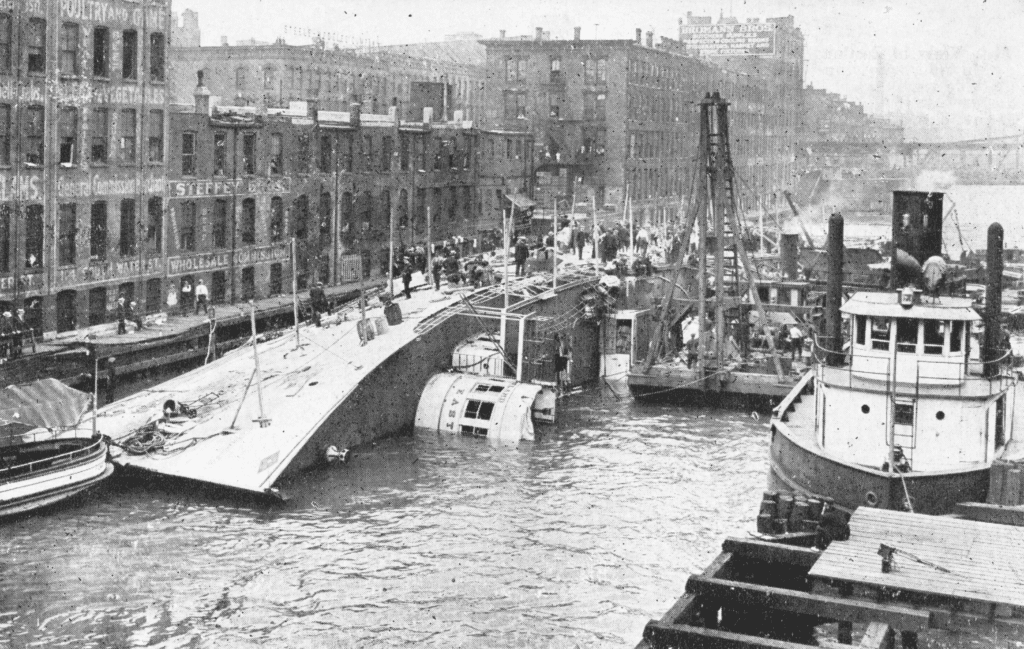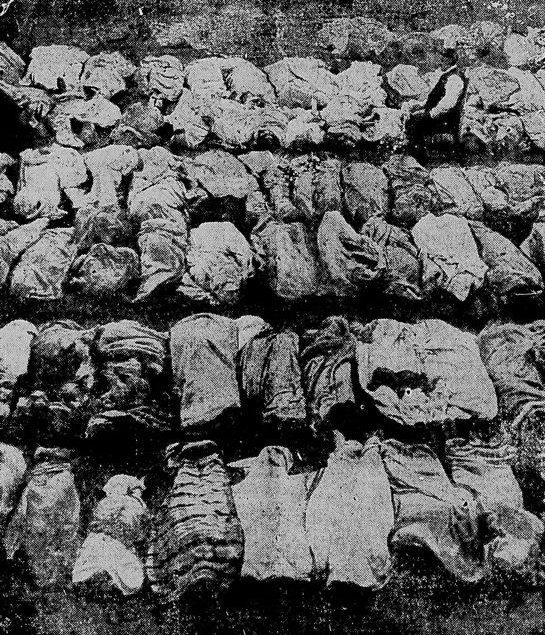Howard Fischer
Uppsala, Sweden

“It would not be possible to praise nurses too highly.”
– Stephen Ambrose, American historian
On July 24, 1915, the Western Electric Company, a technology and engineering giant, had arranged an excursion and picnic for several thousand of its employees. Five Great Lakes excursion boats had been chartered to take them to a park in Indiana, thirty-eight miles across Lake Michigan from the dock in Chicago. The first boat scheduled to depart was the SS Eastland.
The Eastland, 275 feet long, was built in 1903 and had a troubled history. In 1904, she listed to one side and nearly capsized. This happened again in 1906 and in 1912. She had no keel, was top-heavy, and had poorly designed ballast tanks in her hold to keep her upright. In March 1915, after the sinking of RMS Titanic in 1912, the US Congress passed the La Follette Seaman’s Act, which mandated lifeboats capable of holding 75% of a ship’s passengers on certain vessels. The Eastland had then been equipped with eleven lifeboats and thirty-seven life rafts, weighing about 1,100 pounds each, as well as 2,700 life jackets, each weighing six pounds. This safety gear added thirty-four tons for the Eastland to carry. Objections that the ship would be even more unstable were ignored.
By 7:00 that morning, the 2,753 scheduled passengers were on board. Ten minutes later, the ship listed to port (the side away from the wharf) and then righted herself. At about 7:23 AM, she listed again and water entered. By 7:28 she had listed by about 45°, and furniture, pianos, and refrigerators slid across the ship, injuring or killing some passengers. By then she was lying on her side in twenty feet of water, still tied to the dock. The passengers on the upper deck had been thrown off, but those below, on the port side, were trapped.
Nurse Helen Repa (1884–1938) worked for Western Electric. She was going to accompany her fellow employees to the picnic site. She was on a trolley headed for the docks when a mounted policeman stopped all traffic, saying that an excursion boat had capsized, and an ambulance would soon need to pass.

Repa, who was wearing her nurse’s uniform, got off the trolley and jumped on the passing ambulance. Arriving at the waterfront, she helped police and passersby pull people from the water. She then began to triage the passengers. For those who could be sent home, she flagged down passing cars and “requested” that the driver take people home. No one refused. The wounded and those in shock were sent to the nearest hospital, Iroquois Memorial Hospital. Repa asked a policeman how many nurses were on duty at Iroquois. When she heard that there were only two, she got a ride to Iroquois. There she had a hospital employee call the Marshall Field department store and order 500 blankets. She called local restaurants and had soup and hot coffee brought to the hospital. By 10:00 AM, a few more nurses and some doctors were at the waterfront. Repa spent the afternoon moving back and forth between the hospital and the waterfront. She arranged for the dead to be placed in an improvised morgue in a warehouse, and later, in the Second Regiment’s Armory. Towards evening, she went home.
The Eastland disaster claimed the lives of 844 passengers and four crewmen. The Lusitania had sunk with 785 passengers lost. The RMS Titanic’s sinking killed 829 passengers and nearly 700 crew members. Seventy percent of the dead that July day in Chicago were younger than twenty-five years old. There were not enough hearses available; Marshall Field provided thirty-nine trucks.
Blame for the ship’s rollover was placed on Chief Engineer Joseph Erickson for mismanaging the ballast tanks. During the decades-long legal proceedings following the catastrophe, Erickson died. All blame was conveniently placed on him. Captain Harry Pederson was probably negligent, but was never prosecuted.
Victims’ families sued for wrongful deaths, but received little or no compensation. The Eastland was raised in August 1915, and bought by the Illinois US Naval Reserve. She was recommissioned the USS Wilmette and converted into a gunboat used for gunnery training, and remained in service until 1947.
Helen Repa gave only one interview about that tragic day, “The experiences of a Hawthorne [factory] nurse,” which was published in the August 1915 edition of the Western Electric News, and then picked up by several newspapers.
Helen Repa married in 1921, had a son a year later, and stopped working as a nurse.
Sources
- Susan Stranahan. “The Eastland disaster killed more passengers than the Titanic and the Lusitania. Why has it been forgotten?” Smithsonian, October 27, 2014.
- Traci Reynolds. “Only the river remains: Remembering the S.S. Eastland.” Adventures in Cemetery Hopping, July 31, 2015.
- Interview with Helen Repa. “Into the breach.” Lapham’s Quarterly, from “The experiences of a Hawthorn nurse,” 1915. https://www.laphamsquarterly.org/disaster/breach
HOWARD FISCHER, M.D., was a professor of pediatrics at Wayne State University School of Medicine, Detroit, Michigan.

Leave a Reply